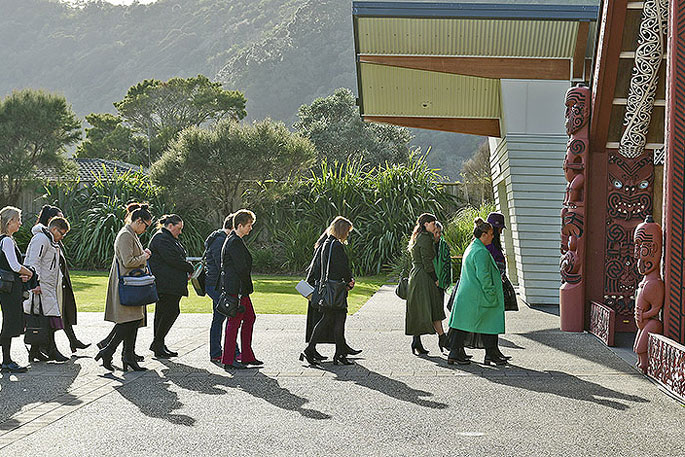The need for collaboration for Bay of Plenty aquaculture to succeed was a recuring theme at last week’s Aquaculture Summit at Te Mānuka Tūtahi Marae in Whakatāne.
Over 150 people representing central, regional and local government, aquaculture industry experts and Bay of Plenty iwi filled the Mātaatua wharenui to discuss the future of the local aquaculture industry.
The summit was organised by the Bay of Plenty Aquaculture Group, in conjunction with Bay of Plenty Regional Council, Whakatāne District Council, Toi-EDA and consultants WSP.
Whakatohea Mussels chief executive Peter Vitasovich acknowledged members of parliament, mayors, councillors and iwi leaders attending the summit, saying while it was the first for the Bay of Plenty, it certainly wouldn’t be the last.
Mr Vitosovich, who has been involved in the seafood industry for several decades, said he had never seen or experienced such a great opportunity for growth of aquaculture as in the Bay of Plenty.
“What lies ahead is something special for our region. We have iwi, hapū, community, industry, central government, local government and research providers working together in a collaborative manner to create a new industry out of nothing.”
Collaboration was the key message for the day.
“Bearing in mind our industry is going to be iwi driven and it’s going to always be for the future generations. There’s no single person, no single iwi, no single company that can do this. It’s got to be done together. If we don’t, this vision will not happen at the speed it deserves.”
Labour party list MP Tāmati Coffey spoke on behalf of the Minister for Oceans and Fisheries, Rachel Brooking, who was unable to attend.
“This is a really exciting opportunity for our community, for our people and our tamariki mokopuna,” he said.
Done well, marine farming produced healthy and sustainable seafood with a low carbon footprint. The government was ambitious about aquaculture and had a strategy with a goal of $3 billion worth of annual sales by 2035.
He talked about how the Government was supporting market access for the aquaculture sector through trade agreements with the United Kingdom and European Union.
“The 20 per cent tariff on our exports of mussels into the United Kingdom will be gone in three years. The EU Free Trade Agreement recently negotiated will, once it comes into force, lead to an estimated annual tariff savings to the seafood industry of $19.6 million a year.
 Politicians, iwi leaders, industry experts and anyone interested in aquaculture was welcomed to Te Mānuka Tūtahi Marae in Whakatane on Friday morning for a full day of speakers.
Politicians, iwi leaders, industry experts and anyone interested in aquaculture was welcomed to Te Mānuka Tūtahi Marae in Whakatane on Friday morning for a full day of speakers.
Bay of Plenty Aquaculture Group chairman Graeme Coates talked about the history of the group. Formed in 2009 with the encouragement of the Bay of Plenty Regional Council, it became an incorporated society in 2021, funded by its members.
He said the only criteria for membership was to be in support of aquaculture, which made it unique in New Zealand.
Group member Haydn Read said the Eastern Bay had a staggering amount of space for potential aquaculture industry, as much as 25,000 to 30,000 hectares with the potential of generating $2-3 billion a year and employing thousands of people. He pointed out some of the challenges that came with that.
“You’ve got to start thinking, wow, that’s a lot of money and that’s a lot of people. What’s the housing solution? What’s the education and training solutions? The size of the prize is huge. We have to do it in an ordered, sensible, well thought out way.”
He said the industry was about more than mussel farming.
“Seaweed is a big industry internationally, worth billions of dollars a year. We’ve got some really interesting seaweed species off our coast. We’re making an application now for some funding to support a foundation for growing that industry in New Zealand. So, watch this space.”
Laws Lawson, principal analyst from Te Ohu Kaimoana, an organisation working to advance Māori interests in the marine environment gave an overview of the Te Moananui-a-Toi Aquaculture Settlement. An act passed in 2004 required the Crown to provide iwi with assets equivalent to 20 percent of all aquaculture space approved since September 1992 in their region.
He said the Bay of Plenty provided the best opportunities in New Zealand for aquaculture.
 Politicians, iwi leaders, industry experts and anyone interested in aquaculture into the wharenui/meeting house.
Politicians, iwi leaders, industry experts and anyone interested in aquaculture into the wharenui/meeting house.
“The regional coastal plan, the one that sets the rules in terms of resource consents, is the most favourable for aquaculture anywhere in the country.
“We will have, in the very near future, the required infrastructure to support aquaculture. A nearby, modern port facility, a new mussel hatchery in the next few years, and a new mussel processing plant.”
However, he warned that open ocean farming came with many risks and that if it was to be successful it would need to be done on a large scale.
"That means if iwi aspirations are to be involved in aquaculture, collaboration is the key.”
Public Interest Journalism funded through NZ On Air.




0 comments
Leave a Comment
You must be logged in to make a comment.